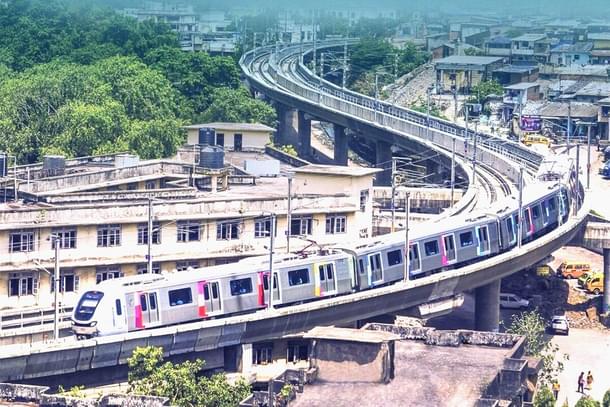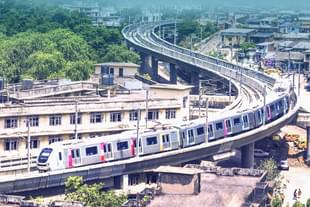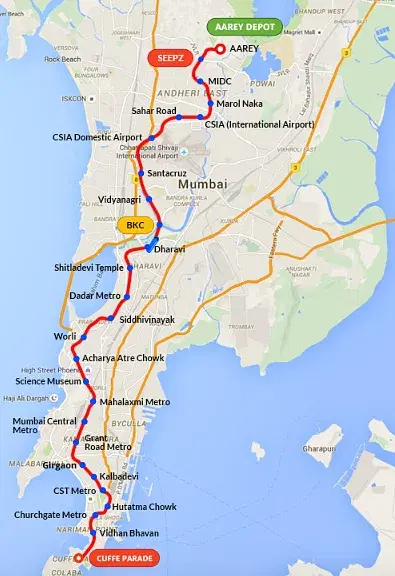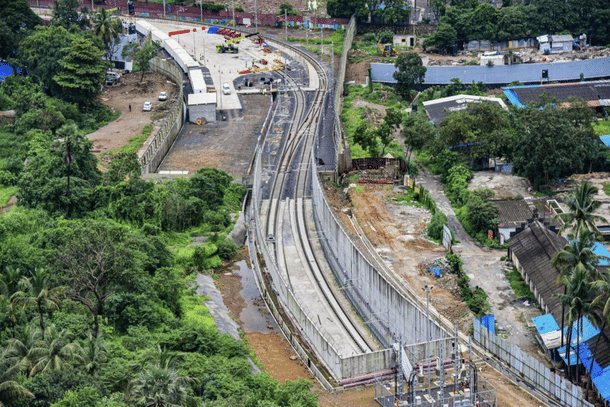Infrastructure
Mumbai Metro 3: Construction On Bandra Kurla Complex-Aarey Stretch Nears Completion, Set for December Launch
V Bhagya Subhashini
May 09, 2023, 12:10 PM | Updated 03:24 PM IST
Save & read from anywhere!
Bookmark stories for easy access on any device or the Swarajya app.


The Mumbai Metro 3, Phase 1 (Bandra Kurla Complex to Aarey) is almost complete, with 87 per cent of the work finished.
Ashwini Bhide, Mumbai Metro's Managing Director and an additional Municipal Commissioner announced this on Saturday (6 May).
Civil and mechanical, electrical and plumbing (MEP) works are being wrapped up, and various system works are being installed. Integrated testing will start after the completion of multiple small works, as stated by Bhide on Twitter.
The underground Metro 3 runs for 33 km from Colaba to Aarey. The corporation will commence activities on this corridor in two phases: from the Bandra Kurla Complex to Aarey and from the Bandra Kurla Complex to Colaba.
The first phase of the project between BKC and SEEPZ is expected to be ready and open to the public by December of this year.
The metro will run with nine rakes of eight coaches each in Phase 1.
The rakes are outfitted with cutting-edge driverless technology, CCTV cameras inside coaches, fire safety equipment, LCD screens for information and infotainment, a programmable digital route map indicator, a dedicated space for wheelchairs, an anti-slip and non-skid floor, and advanced air suspension, among other features.
City’s First Underground Public Transport System
The Colaba-Bandra-SEEPZ Metro Line 3, also known as Aqua Line will be the first underground metro line in Mumbai and also one of the longest underground continuous stretches in India.
The Mumbai Metro Line 3 spans approximately 33.5 km, from Colaba (Cuffe Parade) in the extreme south of the city through Bandra, ending within the Special Electronics Export Processing Zone (SEEPZ) in the north-central.
The Aqua Line connects Mumbai’s most congested regions and key financial hubs such as Nariman Point, Bandra-Kurla-Complex (BKC), Fort, Worli, Lower Parel and Goregaon.

The Metro Line 3 has 27 stations (26 under-ground and one at-grade) of which there are nine underground stations in Phase 1.
These stations are being built at a depth of 20 to 29 metre. The station size has been standardised with platforms designed to fit eight-car trains.
Aarey Depot
Work on the 33-acre car shed at Aarey, that would serve as the base for maintaining metro coaches for Line 3 is on a fast track.
The car depot is at-grade and is located at Aarey Colony, north of Jogeshwari-Vikhroli Link Road. There was a long legal battle over Mumbai’s Metro-3 car shed at Aarey, before it was finally allowed to resume last year.

The Aarey car-depot will have an administrative building, operation control, inspection and maintenance workshops and stabling lines for parking of trains.
Meanwhile, the Phase 1 operations will be handled through the backup Operation Control Centre available at BKC until the Aarey metro depot is ready.
Driverless Operations
Following the commissioning of Phase 1, Mumbai Metro Rail Corporation (MMRC) will apply for safety approval to begin driverless operations on the route.
"Service trials will also be conducted with drivers on board and submitted for CMRS (Commissioner for Metro Rail Safety) approval. Once we have received CMRS clearance for commissioning operations with drivers, we will begin preparing for driverless operations", said Ashwini Bhide.
"Trials of at least six months would be required for CMRS approval to conduct driverless operations. They would be completed concurrently following the commissioning. We will shift to driverless mode once the CMRS approval is received," he added.
V Bhagya Subhashini is a staff writer at Swarajya. She tracks infrastructure developments.




